How the Annual Pendleton Round-Up became the subject of an American Lifeograph documentary.
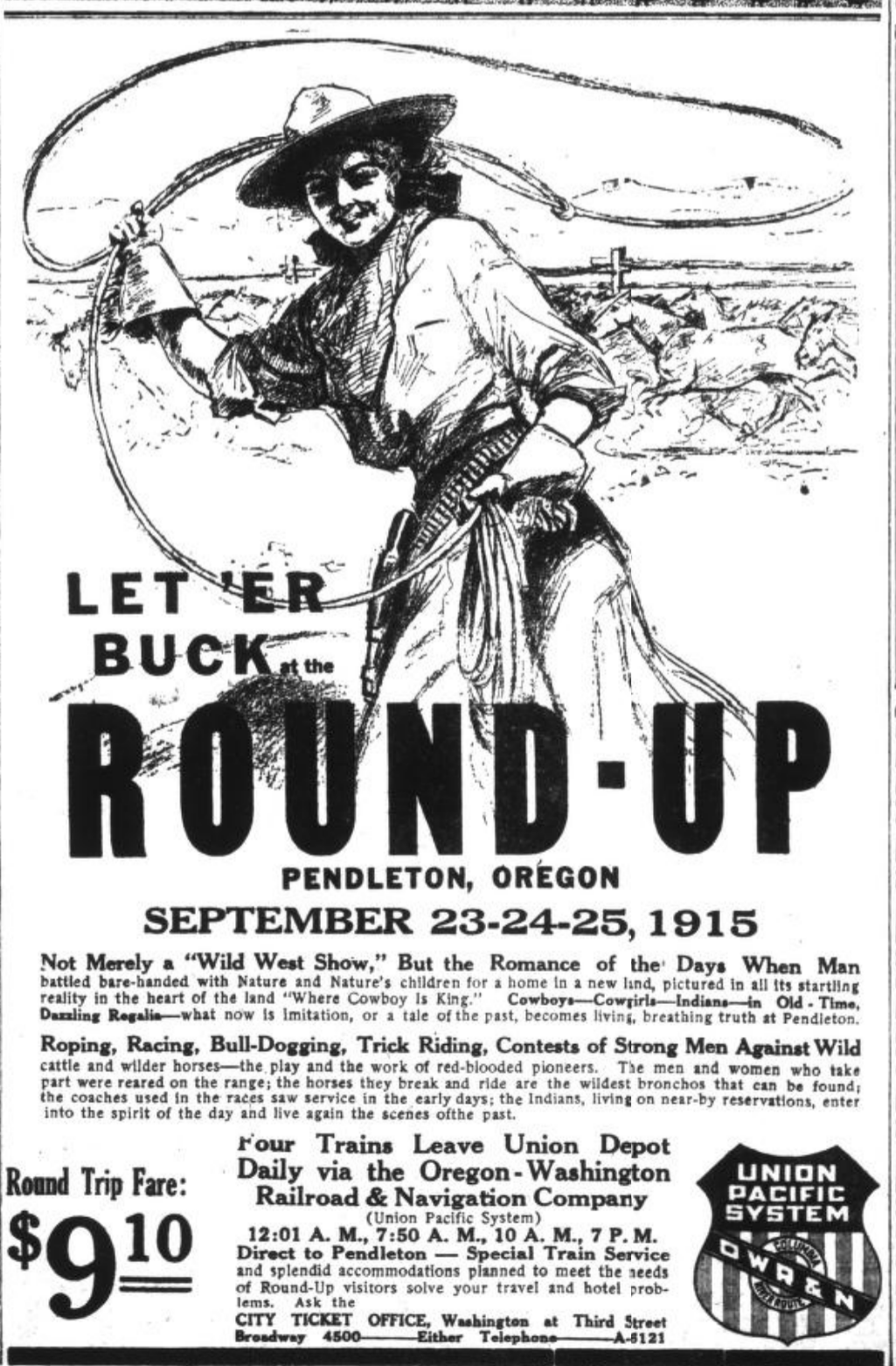
Approximately three hours from Portland sits a comfortable, mid-sized town known as Pendleton. Although the town may be overshadowed by its older neighboring sister, Pendleton has made a name for itself through the years. In fact, the area is the birthplace of Pendleton Woolen Mills, one of America’s most formidable lines of clothing and blankets. And by far, Pendleton is most recognized for its annual Pendleton Round-Up, one of the most prestigious rodeos in the U.S..
The city of Pendleton was officially established on October 25, 1880 with a population of 730 inhabitants. Its early days mostly involved construction and in 1908, the county city hall was erected. The first council’s records and ordinances echo the town’s rich history. The early ordinances of the city handled issues of intoxication in public places, brawls, and the release of guns within the city’s confines. Pendleton faced many obstacles in its infancy but issues of public regard were overcome by the united efforts of citizens and local government authorities.
This meant that Pendleton became a respectable, stand-alone county with local traditions and a spirit for community. Natives and outside visitors of the town patiently waited for Pendleton’s event of the year: The Annual Pendleton Round-Up. The Pendleton Round-Up commenced in September 1910 as a frontier exhibition of equestrian skill that amazed 10,000 onlookers with a guaranteed variety of shows packed over a four-day period. The organizers of the first show administered shows in a little over three months as a community project. For almost one-hundred and twelve years, the Pendleton Round-Up has repeated every year to showcase calf and steer roping, steer wrestling, horse racing, saddle and bareback bronc riding, and bull-riding competitions that encapsulate the fearless nature and grit of the exhilarating ways of life surrounding the American frontier.
The founders of the Pendleton Round-Up were among the city’s branching young professionals and financiers. Overseers of the event, led by Roy Raley, envisioned a program that would place Pendleton on the maps as a name associated with the celebration of the community’s west-bound origins. Taking from the inspiration of Buffalo Bill’s Wild West shows, the Portland Rose Festival, and the Pendleton fairs and festivals that highlighted equestrian skills and horsemanship on top of an authentic depiction of wild-west culture.
Its strive for becoming a persistent force in the community was also met by the significance of high-quality performances led by working cowboys and ranch handlers who’ve committed their lives to the rodeo lifestyle. Over time, the Round-Up had garnered a reputation for enlisting leading contestants and the finest quality livestock to host a fast-paced slew of events.
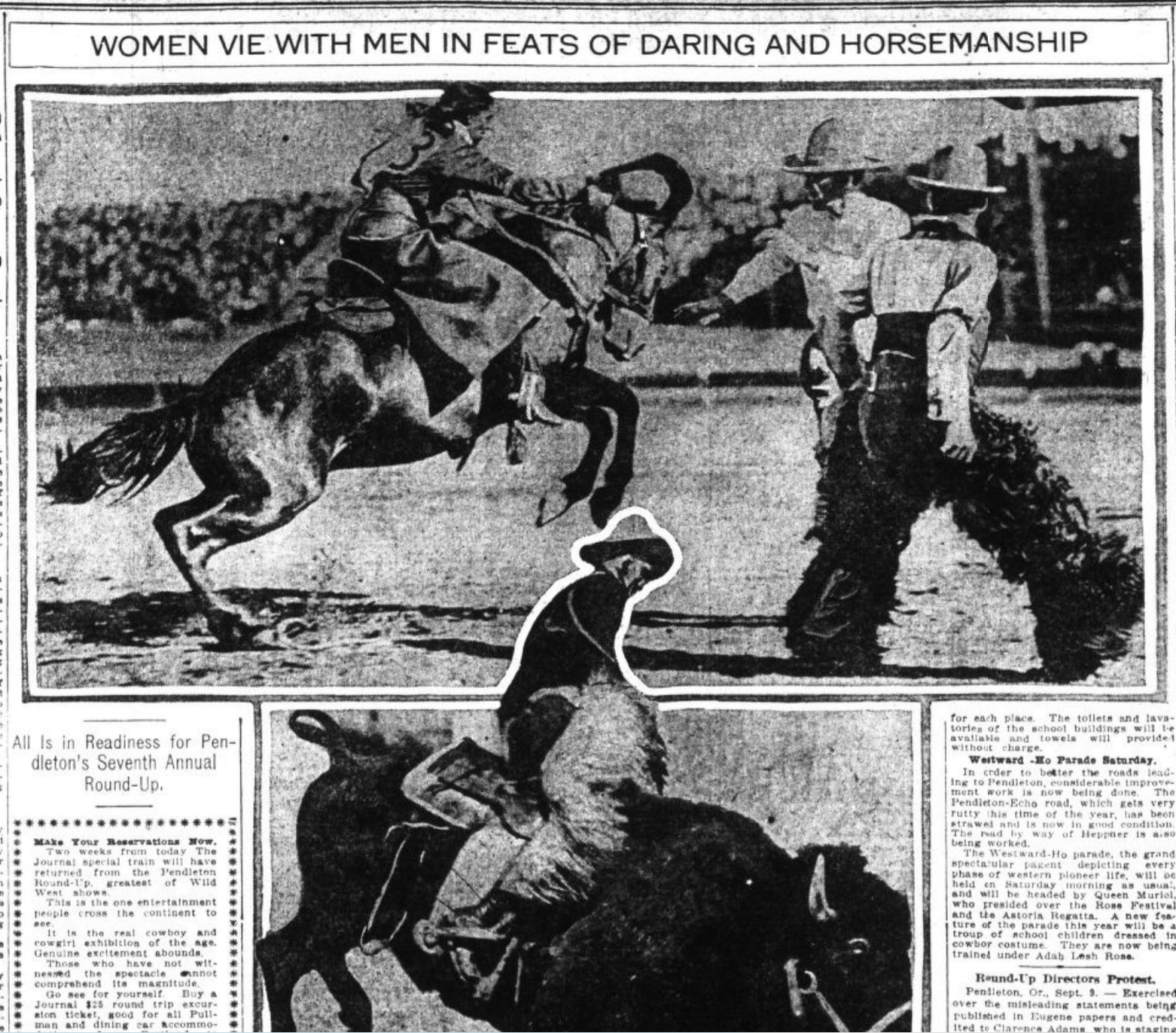
|
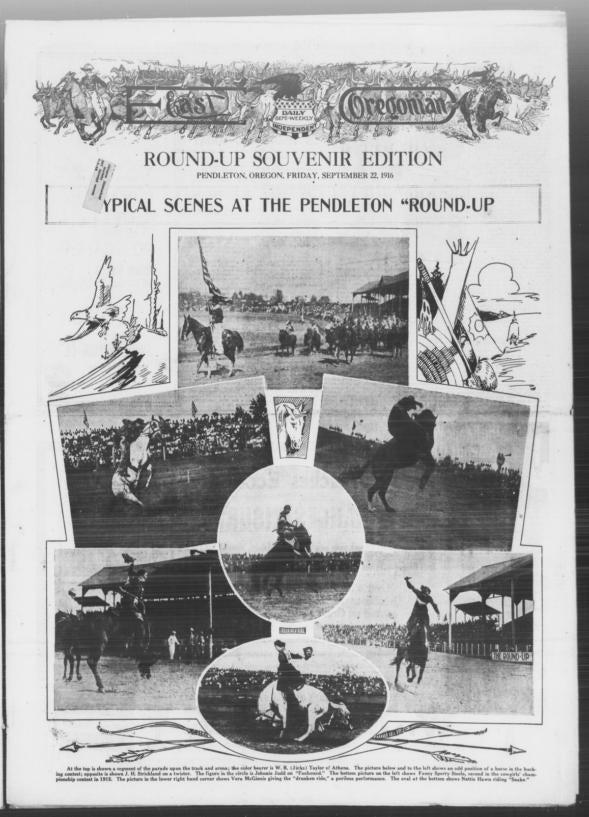
|
From its inception, one of the key elements of the Round-Up, and one that is vital to its repeated success, was the inclusion of Native Americans. Promoters invited citizens from the neighboring Umatilla Indian Reservation for the Cayuse, Umatilla, and Walla Walla tribes (now known as the Confederated Tribes of the Umatilla Indian Reservation) and tribal fellows from all over the Northwest to participate in the program. Round-Up promoters set up teepee camps next to the forum grounds and gave lessons on traditional dancing, weaving and basket making, horsemanship, leatherwork, and beadwork.
The Pendleton Round-Up can also trace its success to the steady influence of advertising across Oregon cities and the combination of artist patronage and musical and stage entertainment centering on the event. The shows would accommodate about 20,000 viewers yearly. In 1913, the Round-Up added a scripted night show to the day’s itinerary. Roy Raley and Anna C. Minthorn Wannassay, a Cayuse tribal member, composed a script for an outdoor pageant that portrayed traditional Indigenous, Native American life prior to white settlement, the intrusion of white pioneers on indigenous lands, and the expansion of the West. The Happy Canyon Pageant was a knock-out success, featuring pantomime acts, a live musical score, and animals on stage.
The success didn’t stop there. The Round-Up which sought out big crowds every September raised the attention of a newly formed American production company based in Portland known as The American Lifeograph Company. Founder Louis Moomaw desired to make a documentary that highlights the thrilling atmosphere of the Pendleton Round-Up, hoping to reach audiences across the U.S. In September of 1913, the American Lifeograph Company shot its debut film Where Cowboy is King (1915). A section from Vol. 24 of American Film Journal “Motography” describes the four reeler as “A picture of real western life taken at Pendleton round-up. Daring skill of the cowboys and the stirring incidents of ranch life give a thrill to the picture. Among the interesting features of this picture are the cowgirls, who equal their brothers in bravery and expert riding. A stagecoach race lends excitement to the picture and one of the chief charms of the production lies in the fact that the thrills are impromptu and the ‘big scenes’ were as much as a surprise to the actors as they prove to be to the audience.”
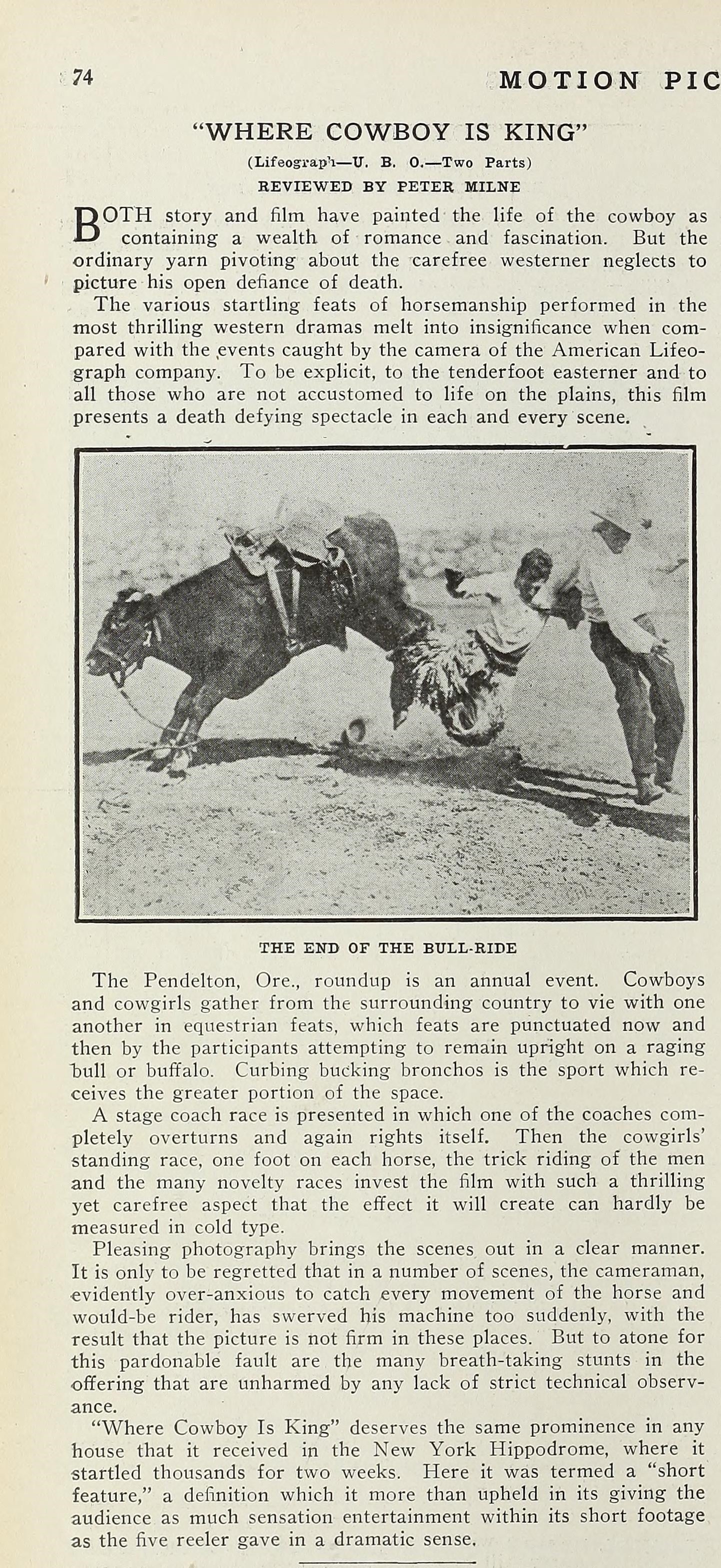
Where Cowboy is King was formally released in 1915 but made appearances in theaters throughout the Northwest as early as late 1914. The film became an overnight box-office success, across the world, making record sales in South America. The favorable outcome prompted The L.J. Schlaifer Attractions of Seattle, Washington to acquire the rights of The American Lifeograph Company, including the exclusive rights to Where Cowboy is King. The film was further exhibited at the Burbank Theater, Los Angeles’ The Star Theater, and several theaters in Idaho and Alaska. Most notably, the film was shown in three theater houses in New York, with the privilege of running twice at the New York Hippodrome, a theater that idolized sensationalism, where it amazed thousands of audience members for two weeks. According to a collection of newspaper articles, Where Cowboy is King had the longest run that any film has ever had at the New York Hippodrome at the time, and was listed to run a third week or until the public was satisfied. Up to the sending of the telegram, approximately 19,000 people a day had watched the film. A news excerpt from the East Oregonian states, “These pictures are creating a furore in New York and are said to assure a tremendous attendance from the East at the next Round-Up. They are now being booked through the South and Middle West as a feature of a big road show attraction.”
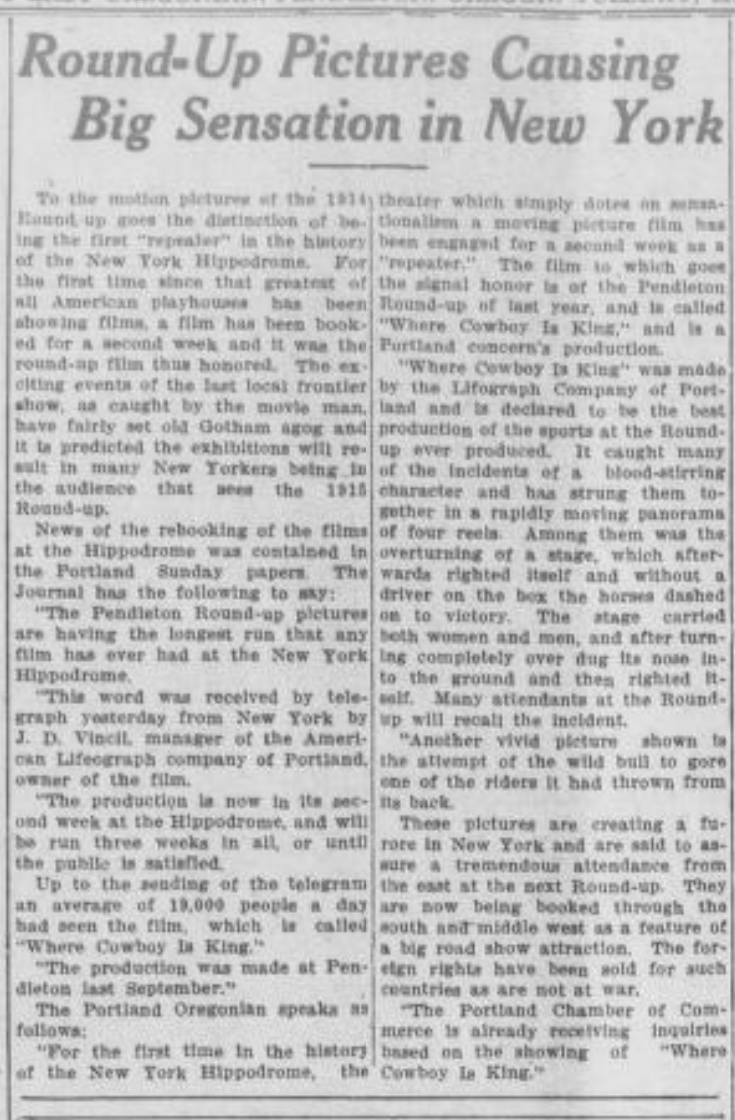
The film became the talk of the town well into the late 1910s. With its clever promotional awareness, the overseers of the Round-Up highlighted the film’s success to invite more spectators for its annual family-fun event.
Sources
“AFI Catalog of Feature Films.” AFI, https://catalog.afi.com/Catalog/moviedetails/2123.
Battistella, Edwin. “Pendleton Round-Up.” The Oregon Encyclopedia
Willingham, William F. “Pendleton Round-Up.” The Oregon Encyclopedia, 14 Mar. 2022.